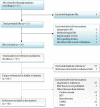Database selection and data gathering methods in systematic reviews of qualitative research regarding diabetes mellitus - an explorative study
- PMID: 33941105
- PMCID: PMC8091751
- DOI: 10.1186/s12874-021-01281-2
Database selection and data gathering methods in systematic reviews of qualitative research regarding diabetes mellitus - an explorative study
Abstract
Background: Systematic reviews (SRs) are considered one of the most reliable types of studies in evidence-based medicine. SRs rely on a comprehensive and systematic data gathering, including the search of academic literature databases. This study aimed to investigate which combination of databases would result in the highest overall recall rate of references when conducting SRs of qualitative research regarding diabetes mellitus. Furthermore, we aimed to investigate the current use of databases and other sources for data collection.
Methods: Twenty-six SRs (published between 2010 and 2020) of qualitative research regarding diabetes mellitus, located through PubMed, met the inclusion criteria. References of the SRs were systematically hand searched in the six academic literature databases CINAHL, MEDLINE/PubMed, PsycINFO, Embase, Web of Science, and Scopus and the academic search engine Google Scholar. Recall rates were calculated using the total number of included references retrieved by the database or database combination divided by the total number of included references, given in percentage.
Results: The SRs searched five databases on average (range two to nine). MEDLINE/PubMed was the most commonly searched database (100% of SRs). In addition to academic databases, 18 of the 26 (69%) SRs hand searched the reference lists of included articles. This technique resulted in a median (IQR) of 2.5 (one to six) more references being included per SR than by database searches alone. 27 (5.4%) references were found only in one of six databases (when Google Scholar was excluded), with CINAHL retrieving the highest number of unique references (n = 15). The combinations of MEDLINE/PubMed and CINAHL (96.4%) and MEDLINE/PubMed, CINAHL, and Embase (98.8%) yielded the highest overall recall rates, with Google Scholar excluded.
Conclusions: We found that the combinations of MEDLINE/PubMed and CINAHL and MEDLINE/PubMed, CINAHL, and Embase yielded the highest overall recall rates of references included in SRs of qualitative research regarding diabetes mellitus. However, other combinations of databases yielded corresponding recall rates and are expected to perform comparably. Google Scholar can be a useful supplement to traditional scientific databases to ensure an optimal and comprehensive retrieval of relevant references.
Keywords: Databases; Diabetes mellitus; Literature search; Qualitative research; Systematic review.
Conflict of interest statement
The authors declare that they have no competing interests.
Figures



Similar articles
-
Database coverage and their use in systematic reviews regarding spinal manipulative therapy: an exploratory study.Chiropr Man Therap. 2022 Dec 19;30(1):57. doi: 10.1186/s12998-022-00468-8. Chiropr Man Therap. 2022. PMID: 36536437 Free PMC article.
-
Beyond the black stump: rapid reviews of health research issues affecting regional, rural and remote Australia.Med J Aust. 2020 Dec;213 Suppl 11:S3-S32.e1. doi: 10.5694/mja2.50881. Med J Aust. 2020. PMID: 33314144
-
The comparative recall of Google Scholar versus PubMed in identical searches for biomedical systematic reviews: a review of searches used in systematic reviews.Syst Rev. 2013 Dec 23;2:115. doi: 10.1186/2046-4053-2-115. Syst Rev. 2013. PMID: 24360284 Free PMC article.
-
Information sources for obesity prevention policy research: a review of systematic reviews.Syst Rev. 2017 Aug 8;6(1):156. doi: 10.1186/s13643-017-0543-2. Syst Rev. 2017. PMID: 28789703 Free PMC article. Review.
-
Optimal literature search for systematic reviews in surgery.Langenbecks Arch Surg. 2018 Feb;403(1):119-129. doi: 10.1007/s00423-017-1646-x. Epub 2017 Dec 5. Langenbecks Arch Surg. 2018. PMID: 29209758 Review.
Cited by
-
Efficient searching for NICE public health guidelines: Would using fewer sources still find the evidence?Res Synth Methods. 2022 Nov;13(6):760-789. doi: 10.1002/jrsm.1577. Epub 2022 Jun 23. Res Synth Methods. 2022. PMID: 35657294 Free PMC article.
-
Peripheral Neuropathy Instruments for Individuals with Cancer: A COSMIN-Based Systematic Review of Measurement Properties.Curr Oncol. 2024 Dec 6;31(12):7828-7851. doi: 10.3390/curroncol31120577. Curr Oncol. 2024. PMID: 39727700 Free PMC article.
-
Chemical composition and pharmacological aspects of Malaysian stingless bee propolis: An up‑to‑date systematic review.Biomed Rep. 2024 Nov 5;22(1):9. doi: 10.3892/br.2024.1887. eCollection 2025 Jan. Biomed Rep. 2024. PMID: 39559820 Free PMC article.
-
Occupational Disease and Injury in Malaysia: A Thematic Review of Literature from 2016 to 2021.J Environ Public Health. 2023 Jan 31;2023:1798434. doi: 10.1155/2023/1798434. eCollection 2023. J Environ Public Health. 2023. PMID: 36761248 Free PMC article. Review.
-
Scientific Literature Database Coverage of Randomized Clinical Trials for Central Serous Chorioretinopathy.J Pers Med. 2023 Jun 12;13(6):983. doi: 10.3390/jpm13060983. J Pers Med. 2023. PMID: 37373972 Free PMC article.
References
-
- Muka T, Glisic M, Milic J, Verhoog S, Bohlius J, Bramer W, Chowdhury R, Franco OH. A 24-step guide on how to design, conduct, and successfully publish a systematic review and meta-analysis in medical research. Eur J Epidemiol. 2020;35(1):49–60. - PubMed
-
- Higgins JPT, Thomas J, Chandler J, Cumpston M, Li T, Page MJ, Welch VA (editors). Cochrane Handbook for Systematic Reviews of Interventions version 6.2 (updated February 2021). Cochrane. 2021. Available from www.training.cochrane.org/handbook.
MeSH terms
LinkOut - more resources
Full Text Sources
Other Literature Sources
Medical
Research Materials
Miscellaneous

